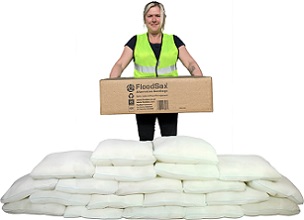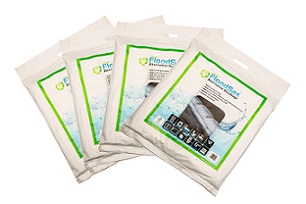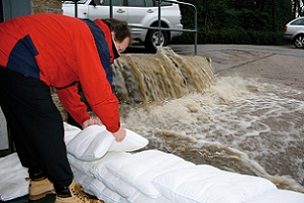 London in the rain. Photo by Trev W Adams on Pexels.
London in the rain. Photo by Trev W Adams on Pexels.
 All these 20 FloodSax alternative sandbags came from this one easy-to-carry box
All these 20 FloodSax alternative sandbags came from this one easy-to-carry box
 FloodSax come in vacuum-packed packs of five
FloodSax come in vacuum-packed packs of five
 FloodSax sandless sandbags holding back a deluge of floodwater
FloodSax sandless sandbags holding back a deluge of floodwater
London firefighters now called to more than 8,000 flooding incidents a year
London Fire Brigade is now responding to more than 8,000 calls a year to flooding … and the number is continually rising.
The emergency pleas for help from the public have increased by almost a third over the last 10 years and absolutely skyrockets in times of flash flooding caused by cloudbursts.
In September 2024, one flash flood prompted around 350 emergency calls with crews sent to Ruislip, Uxbridge, Wimbledon and Carshalton. Firefighters rescued people trapped in vehicles, assisted residents evacuating their homes and responded to flooding in underground stations, roads and commercial properties.
The worst flash flooding in recent history came in July 2021 when the Brigade’s control received 1,000 calls for help after 47.8mm of rain fell in a 24-hour period, compared to the monthly average monthly of 41mm.
London Fire Brigade says Londoners must take proactive steps to protect themselves and their properties from flooding as local councils have absolutely no responsibility to provide sandbags or any other flood protection for homes and businesses.
Although flash floods triggered by heavy rainfall hit the headlines, floods in London can also be caused by burst water mains, roof and plumbing failures.
Assistant Commissioner for Operational Resilience and Control, Patrick Goulbourne, said: “We’re calling on Londoners to be ready for the extreme weather we’re experiencing on an increasingly regular basis. Flooding can occur year-round, not just in winter, and its impact on property and infrastructure can be severe.
“The Brigade is fully prepared to respond to flood emergencies with both rescue and pumping equipment. But prevention and awareness are key to minimising disruption, safeguarding property and keeping people safe.”
During flood emergencies where the Brigade receives a high volume of calls, control officers implement batch mobilising which means prioritising life-threatening calls and attending to other calls as non-emergencies.
Many London borough councils, along with businesses and hundreds of London residents, now have FloodSax alternative sandbags so they are prepared for flooding anytime day or night all year round. FloodSax are space-saving to store yet quick and easy to deploy.
They were devised by Yorkshire-based entrepreneur Richard Bailey who said London is particularly vulnerable to flooding with so many apartments at basement or street level.
He said: “Water wrecks everything it touches and with so many basement and ground-floor flats at risk in London, the danger they will become flooded is ever present. People think councils will come to save them with sandbags if imminent flooding is forecast but that’s simply not the case. Councils have absolutely no responsibility to provide sandbags or other temporary flood prevention measures to anyone. People must protect their own homes and businesses.”
After the 2021 flash floods in London it was revealed that almost half its hospitals, one in five schools and a quarter of London’s rail stations are at risk of flooding.
The statistics revealed by City Hall also say around 200,000 homes and workplaces are at medium or high risk of surface water floods.
Hackney, Brent, Tower Hamlets, Newham, Islington, Hammersmith and Fulham are all at particularly high risk of flooding.
London Underground stations are often flooded, with FloodSax used on the Tube to stop floodwater or soak it up.
Flash flooding can happen anywhere at any time with people having virtually no time to react which is why FloodSax are needed so badly as they are incredibly flexible and multi-purpose.
In their dry state the gelling polymer inside FloodSax can quickly soak up water dripping or leaking inside buildings to stop damage from spreading. Immerse them fully in water and they absorb the water and retain it, transforming them into instant sandbags but without any sand so they are more environmentally friendly than traditional sandbags.
Around 3 million have now been sold worldwide for flood resilience, flood protection and flood control. To find out where to get them got to https://www.floodsax.co.uk/buy/uk-suppliers